

Parenteral Provision of Micronutrients to Pediatric Patients: An International Expert Consensus Paper - Hardy - 2020 - Journal of Parenteral and Enteral Nutrition. Answer 9: The greatest risk is not providing micronutrients in a PN regimen.
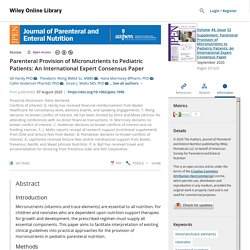
Rationale. ESPEN guideline on home parenteral nutrition - Clinical Nutrition. 2.2 Search strategy 1.
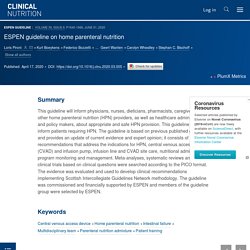
Indications for HPN 1. What are the indications for HPN? Recommendation 1 HPN should be administered to those patients unable to meet their nutritional requirements via the oral and/or enteral route and who can be safely managed outside of the hospital. Grade of Recommendation: GPP – Strong consensus (95.8% agreement) Commentary.
Parenteral Provision of Micronutrients to Adult Patients: An Expert Consensus Paper - Blaauw - 2019 - Journal of Parenteral and Enteral Nutrition. Recommendation During the acute phase response associated with disease‐related inflammation, a redistribution of micronutrients out of the circulating compartment occurs under the influence of pro‐inflammatory cytokines.
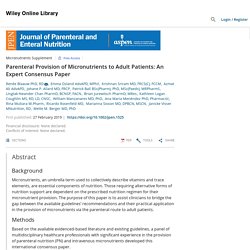
The decrease in serum concentrations being proportionate to the magnitude of the inflammation, the simultaneous determination of serum C‐reactive protein (CRP) levels along with micronutrient assessment is required for their interpretation. In those receiving PN support, daily IV MV and MTE provision usually prevents the development of micronutrient deficiencies. Rationale Critical illness represents an extreme form of metabolic stress, which exhibits a phased response (ebb followed by flow phase).27 Physiologically the metabolic changes associated with metabolic stress are referred to as the acute phase response. In response to increased cytokine levels, vitamins A, C, E, and D will decrease below the lower reference values, and so will Fe, Se, Zn,4 Mn, and Mo.
Acute care. ESPGHAN/ESPEN/ESPR/CSPEN Guidelines on pediatric parenteral nutrition. Supplemental Parenteral Nutrition: Review of the Literature and Current Nutrition Guidelines - Russell - 2018 - Nutrition in Clinical Practice. Use of Intravenous Fat Emulsions in Adult Critically Ill Patients: Does omega 3 make a difference? The PDF file you selected should load here if your Web browser has a PDF reader plug-in installed (for example, a recent version of Adobe Acrobat Reader).

If you would like more information about how to print, save, and work with PDFs, Highwire Press provides a helpful Frequently Asked Questions about PDFs. Alternatively, you can download the PDF file directly to your computer, from where it can be opened using a PDF reader. To download the PDF, click the Download link above. Fullscreen Fullscreen Off S Afr J Clin Nutr: ISSN (Print): 1607-0658, ISSN (Web): 2221-1268 The South African Journal of Clinical Nutrition (SAJCN) is peer reviewed and an approved South African journal for the measurement of research output of public higher education institutions (Department of Education (DE) accredited).
SAJCN is proudly published by Medpharm Publications (Pty) Ltd, PO Box 14804, Lyttelton, 0157, RSA, Tel: +27 12 664 7460, Fax: +27 12 664 6276, Website: www.medpharm.co.za. Nutrition support for adults: oral nutrition support, enteral tube feeding and parenteral nutrition. This guideline covers identifying and caring for adults who are malnourished or at risk of malnutrition in hospital or in their own home or a care home.
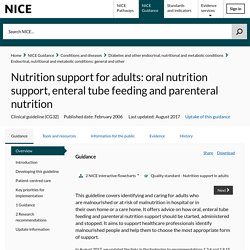
It offers advice on how oral, enteral tube feeding and parenteral nutrition support should be started, administered and stopped. It aims to support healthcare professionals identify malnourished people and help them to choose the most appropriate form of support. In August 2017, we updated the links in the footnotes to recommendations 1.3.4 and 1.8.15. Management of Parenteral Nutrition in Hospitalized Adult Patients. Parenteral Nutrition and Intestinal Failure. The aforementioned strategies are important components of SBS management, especially for milder cases.

However, for the majority of patients with severe SBS, HPN is the cornerstone of therapy. Patients who require long-term PN cannot be kept in hospital indefinitely, and thus transition to HPN when they are clinically stable. There are four typical settings in which HPN is administered: IF due to surgical complications in the cool-down period prior to subsequent surgical intervention; IF due to cancer, where life expectancy is otherwise beyond that when death would occur from lack of nutrition (typically 3 months or greater); SBS following bowel resection where PN may be continued indefinitely or eventually weaned; and Type 3 IF due to miscellaneous causes such as dysmotility.
There is significant global variation in the indications for HPN. In the UK, the main indications are Crohn’s disease, intestinal ischemia, and surgical complications [3]. European Journal of Clinical Nutrition - Parenteral trace element provision: recent clinical research and practical conclusions. Top of page Introduction In human physiology, inorganic elements that are found in low concentrations in body tissues and fluids are generally termed as trace elements.1 For nine trace elements, at least one important physiological function in human metabolism is known.

These trace elements are ranked as essential micronutrients and should be regularly consumed through foods and/or supplements. Artificial nutrition for patients unable to orally consume sufficient food must provide all physiologically essential macronutrients and micronutrients to avoid symptoms of deficiency and to prevent further aggravation of the underlying disease. Management of Parenteral Nutrition in Hospitalized Adult Patients. Guideline: Updates on HIV and Infant Feeding: The Duration of Breastfeeding, and Support from Health Services to Improve Feeding Practices Among Mothers Living with HIV - NCBI Bookshelf.
Australasian society for parenteral and enteral nutrition (AuSPEN) adult vitamin guidelines for parenteral nutrition. Standardized Competencies for Parenteral Nutrition Order Review and Parenteral Nutrition Preparation, Including Compounding. ESPGHAN Committee on Nutrition Position Paper. Intravenous L... : Journal of Pediatric Gastroenterology and Nutrition. What Is Known * There is evidence that intravenous lipid emulsions (ILE) play a role in the pathogenesis of cholestasis and parenteral nutrition–associated liver disease. * A number of trials have suggested that novel fish oil–containing ILE could have a beneficial effect on cholestasis and parenteral nutrition–associated liver disease.
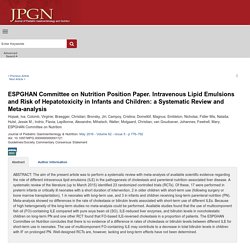
What Is New * The present systematic review identified 23 randomized controlled trials, which evaluated the effect of different ILEs on cholestasis. * Meta-analysis showed no differences in the rate of cholestasis or bilirubin levels associated with short-term use of different ILE formulations in preterm infants, neonates, and children. * Although quality data are lacking there is some evidence that the use of multicomponent fish oil–containing ILE may contribute to a decrease in total bilirubin levels in children with intestinal failure on prolonged parenteral nutrition. Oxidative Stress Phytosterols Activation of the Reticuloendothelial System ILE (10% vs 20%) A.S.P.E.N. Clinical Guidelines: Parenteral Nutrition Ordering, Order Review, Compounding, Labeling, and Dispensing. A.S.P.E.N. Parenteral Nutrition Safety Consensus Recommendations. Nursing care during PN infusion centers on administering the infusion as prescribed, preventing complications, monitoring metabolic stability, assessing progress toward therapeutic goals, and documenting patient response to therapy.

A.S.P.E.N. Clinical Guidelines: Support of Pediatric Patients With Intestinal Failure at Risk of Parenteral Nutrition–Associated Liver Disease.